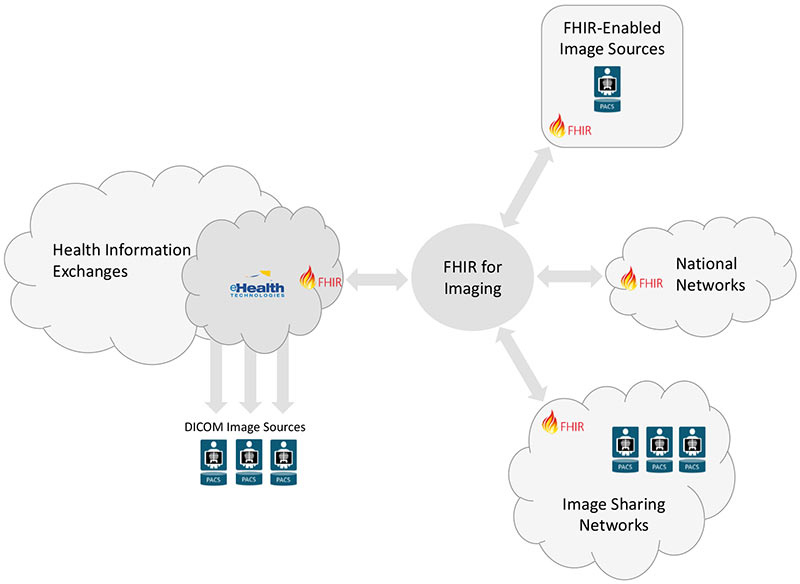Since the advent of electronic medical records, and even earlier, one of the most challenging barriers to a more interoperable healthcare ecosystem has been ready access to medical images, perhaps more than any other component of healthcare records. Images have continually remained sequestered in isolated PACS archives, particularly inaccessible to healthcare providers, patients and payers across the community who need them to deliver high quality, efficient care. Yet access to these images is needed, including the following regularly occurring situations:
- Radiologists, cardiologists and other image-intensive specialists need frequent access to non-imaging clinical information to augment images, which consumes a significant portion of their time and effort. These same care providers also require prior images from external locations to be available locally in order to properly interpret and diagnose, which until recently was only possible by way of extraordinarily manual and labor intensive means such as burning CDs.
- Healthcare providers at large, including referring physicians and other care providers across the community, need access to medical images to complement the information available to them in their own EMRs, in order to make more clinically-informed decisions. Again, other than by extraordinarily burdensome means, those images are often not available without costly and time-consuming manual effort.
- Patients increasingly demand access to medical images as a part of their overall health history, as they seek to take control of their personal health record by way of smartphone apps and online portals that need the ability to take in and share health data in a relevant yet secure way. Medical images have been largely inaccessible to patients other than by way of manual retrieval.
These critical needs are just beginning to be addressed in a few important ways:
- National health data sharing networks such as the CommonWell Health Alliance, and organizations that establish interoperability frameworks such as Carequality are moving aggressively to drive nationwide care coordination, yet most of these real-world implementations have yet to incorporate medical image sharing to a significant degree.
- Cloud-based medical image-sharing networks are another way that some industry players have attempted to address these needs. They allow providers to share medical images among themselves by uploading and downloading images from the cloud. However most operate independently from medical record sharing networks, such as health information exchanges.
- HIEs and other clinical information networks have begun to break down these barriers by incorporating Image Exchange from eHealth Technologies. By simply plugging this image sharing service into their existing HIE platform, their constituents will have medical images from any connected location in the community served by the HIE readily available at their fingertips. While a mature DICOM imaging standard makes this relatively straightforward, the time and effort required to establish these connections remains a significant component of overall cost.
Recently, the FHIR interoperability standard has played an increasing role in accelerating some of these initiatives, as it is built on modern technologies that reduce barriers to access and integration. Traditionally, specialized tools and skillsets were required integrate disparate data sources, whereas FHIR is built on common, standardized technologies that are widely used and understood. FHIR has been frequently utilized as a standard for querying and retrieving specific clinical information between systems. It is perhaps most frequently leveraged within APIs that enable patient-centered apps to access health data from EMRs, or as for clinical decision support by enabling cross-system queries to facilitate use cases such as drug-drug interaction checking. In the imaging domain, FHIR has been predominantly focused on querying EMRs for relevant patient data in order to enable image-intensive specialists such as radiologists to access nonimage data in support of diagnostic reading and clinical decision making.
eHealth Technologies is pioneering new applications of FHIR for imaging that promises to significantly improve how medical images can be incorporated into an interoperable health IT ecosystem; one that spans across communities, regions, states and even countries by way of our many partnerships with HIEs. It will further enable medical imaging to live alongside other medical records, promoting it to the same level of exposure and access. With FHIR as a part of our solution we can also leverage more of the existing frameworks being built within the FHIR ecosystem to manage challenges such as consent and security auditing and such, further simplifying the integration process.

Direct access to images: With eHealth Technologies’ new FHIR for Imaging application care providers can directly access images from more locations by embedding FHIR services directly within the Image Exchange platform. This advancement opens up immediate opportunities to connect medical imaging sources to Health Information Exchanges that might otherwise be inaccessible. In the coming months, by leveraging standards-based FHIR connections, HIEs will be able to access medical images from institutions that are participating in cloud-based image sharing networks. This will allow HIE constituents – healthcare providers, patients and potentially payers – to access to the full history of medical images for their patients, including the ability to view, compare and import medical images in conjunction with their patient’s community-wide health record; just as they do today from DICOM-enabled connections. This new application of FHIR bridges the gap between HIEs and previously autonomous image sharing networks, enhancing the value delivered to the healthcare community at large with a richer, more complete dataset that facilitates more clinically-informed decision making.
Our vision for the future: These applications of FHIR in imaging represent yet another significant step that contributes to building a truly interoperable health IT ecosystem. With these capabilities in place, additional participants in the previously isolated image sharing networks can be more readily connected to their respective HIEs. As more and more medical imaging systems, such as radiology and cardiology PACS are FHIR-enabled, they too can more readily share their images with external networks such as HIEs. And finally, as national networks take hold and become enriched with medical images, their ability to share images with health information exchanges using these same FHIR-based approaches will grow.